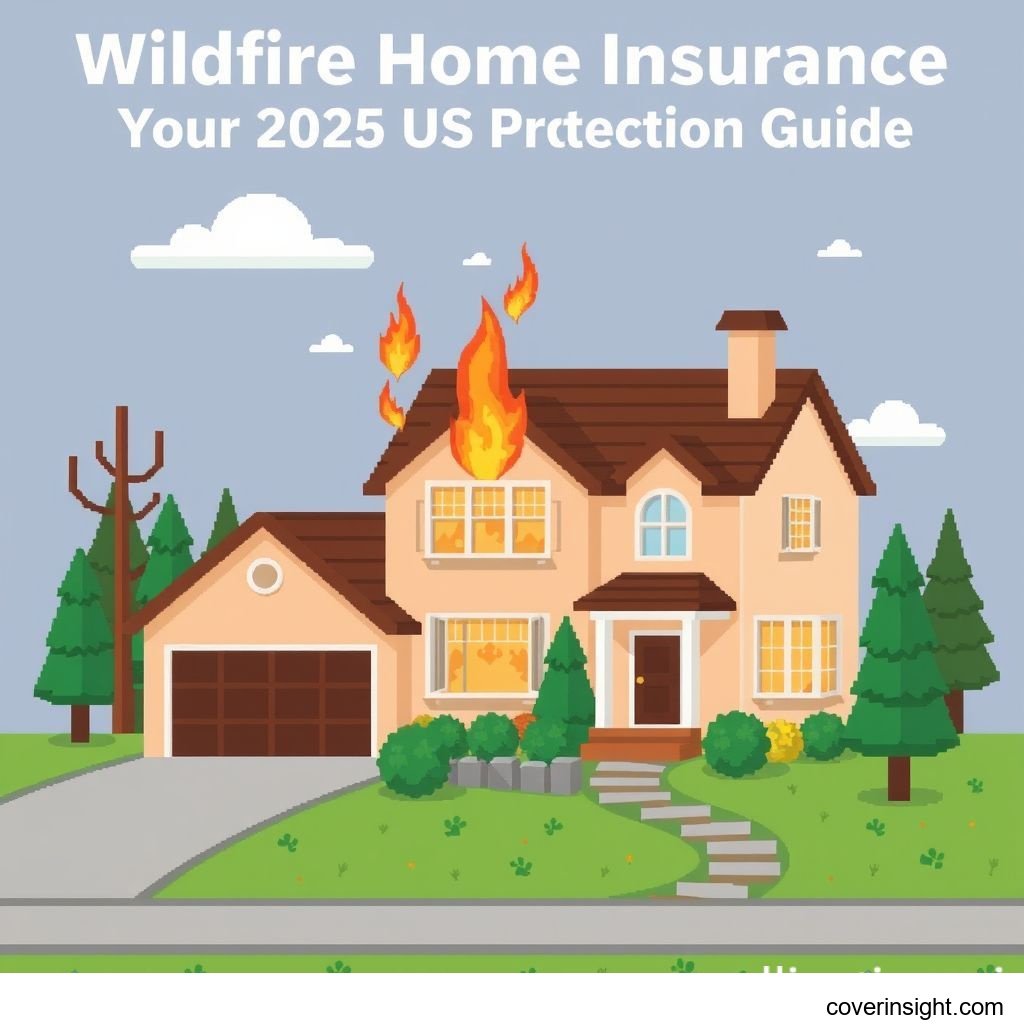Introduction
The landscape of US wildfire home insurance is rapidly evolving, presenting new challenges and considerations for homeowners in 2025. As wildfire seasons intensify across the United States, particularly in Western states, understanding your protection becomes paramount. Homeowners often worry about rising premiums, reduced availability, and adequate coverage for their properties. This comprehensive guide aims to address these concerns, offering clarity on securing essential US wildfire home insurance for the coming year. It's crucial to equip yourself with the knowledge to protect your most valuable asset.
Understanding the Evolving Wildfire Risk in 2025
Wildfires pose an increasing threat to residential areas across the US, making robust US wildfire home insurance more critical than ever. Climate change, urban sprawl into wildland-urban interface (WUI) areas, and drought conditions contribute to longer, more destructive fire seasons. In 2025, many regions are re-evaluating risk assessments, directly impacting insurance availability and cost. Homeowners in high-risk zones, such as those seeking California home insurance wildfire options, are experiencing significant shifts in the market. Understanding your specific risk profile is the first step toward effective property protection.
Here are some key trends affecting wildfire risk:
-
Increased frequency and intensity of large fires.
-
Expansion of development into previously undeveloped areas.
-
More complex fire behavior due to climate factors.
Core US Wildfire Home Insurance Coverage Details
Securing appropriate US wildfire home insurance involves understanding what your policy includes and excludes. Standard homeowners policies often provide some level of fire coverage. However, specialized wildfire insurance 2025 considerations are emerging, especially for properties in fire-prone regions. It’s vital to review your policy details carefully to ensure adequate protection against wildfire damage. For more insights on general insurance topics, explore resources like Insurance Resources Global.
What's Typically Included
A robust US wildfire home insurance policy typically covers several critical areas. This includes damage to your dwelling structure and other structures on your property, like garages or sheds. Personal belongings, such as furniture, electronics, and clothing, are also usually protected up to a specified limit. Additional living expenses (ALE) are another crucial component, covering costs if you need to evacuate and cannot live in your home due to wildfire. This aspect of coverage provides much-needed financial relief during displacement.
Common inclusions often feature:
-
Dwelling coverage for the main house.
-
Other structures coverage for detached buildings.
-
Personal property coverage for your belongings.
-
Additional living expenses (ALE) for temporary housing.
Common Exclusions and Limitations
While comprehensive, US wildfire home insurance policies do have common exclusions and limitations. For instance, some policies might not cover damage from smoke or ash if not directly caused by a covered wildfire event. Landscaping, fences, or trees might have limited coverage or be entirely excluded. It's also important to note that many standard policies may cap coverage for certain types of damage or require specific mitigation efforts from homeowners to maintain their policy. Understanding these nuances is crucial, particularly for California home insurance wildfire policies, where specific state regulations might apply. Always consult your policy document or agent for precise details on your protection.
Analyzing US Wildfire Home Insurance Costs in 2025
The cost of US wildfire home insurance can vary significantly in 2025. Factors like your home's location, construction materials, and the presence of defensible space heavily influence your premium. As the risk of wildfires grows, so too does the complexity of pricing these essential policies. Homeowners are keen to understand what drives these costs and how they can manage them effectively.
Key Factors Influencing Your Premium
Several key factors determine the premium for your US wildfire home insurance. Your property's proximity to forested areas or brush is a primary driver. Homes built with fire-resistant materials, such as stucco or metal roofs, often qualify for lower rates. The availability of water sources and the local fire department's response time also play a significant role. Furthermore, your claims history and the specific coverage limits you choose will directly impact the overall cost of your wildfire insurance 2025 policy. Always review these elements with your insurer.
Factors affecting your US wildfire home insurance premium include:
-
Location: High-risk zones incur higher premiums.
-
Construction Materials: Fire-resistant materials can reduce costs.
-
Defensible Space: Creating a buffer around your home is key.
-
Local Fire Protection: Proximity to fire stations and hydrants matters.
-
Claims History: Past claims can impact future rates.
Strategies for Saving on Your Policy
Managing the cost of US wildfire home insurance requires proactive steps. Implementing fire mitigation measures, such as creating defensible space around your property, can lead to discounts. This involves clearing brush, trimming trees, and maintaining proper spacing between structures and vegetation. Installing fire-resistant vents or upgrading your roof with non-combustible materials can also significantly reduce your premium. Bundling your home insurance with other policies, like auto insurance, from the same provider often results in savings. Exploring options for wildfire insurance 2025 requires diligence and strategic planning. You can also visit US Insurance Home for general insurance guidance.
Consider these tips for potential savings:
-
Create Defensible Space: Maintain clear zones around your home.
-
Harden Your Home: Use fire-resistant building materials.
-
Install Protective Measures: Consider sprinkler systems or ember-resistant vents.
-
Shop Around: Compare quotes from multiple providers.
-
Increase Deductible: A higher deductible can lower your premium.
-
Bundle Policies: Combine home and auto insurance.
Navigating Claims and Renewals for Wildfire Protection
Understanding the claims process and policy renewals is crucial for effective US wildfire home insurance. If a wildfire impacts your home, prompt reporting to your insurer is essential. Documenting all damage with photos and videos will support your claim significantly. For renewals, be aware that insurers may adjust terms or premiums based on updated risk assessments in 2025. Some homeowners, particularly those seeking California home insurance wildfire policies, might find their current insurer non-renewing their policy, necessitating a search for new coverage. This is where preparedness is key.
Essential FAQs About US Wildfire Home Insurance
Here are answers to common questions about US wildfire home insurance in 2025. These insights offer valuable protection information for homeowners navigating the complexities of the current market.
How much does US wildfire home insurance cost in US?
The cost of US wildfire home insurance varies widely. It depends on factors like your location, the value of your home, and the specific coverage you select. Homeowners in high-risk areas will generally pay more than those in lower-risk zones. Premiums can range from a few hundred to several thousand dollars annually.
What affects US wildfire home insurance premiums?
Many factors affect US wildfire home insurance premiums. These include your home's construction type, its proximity to hazardous vegetation, and the quality of local fire department services. Individual loss history and the amount of coverage you choose also play significant roles in determining your policy's premium.
Is US wildfire home insurance mandatory in US?
US wildfire home insurance is not explicitly mandatory by law across the entire US. However, if you have a mortgage, your lender will almost certainly require you to carry homeowners insurance, which typically includes fire coverage. In high-risk areas, a standard policy might not be enough, and specific wildfire insurance 2025 coverage may be necessary to satisfy lender requirements or provide adequate protection. For more detailed information on regulations, you can check with your State Insurance Departments or the National Association of Insurance Commissioners.
How to choose the best US wildfire home insurance policy?
To choose the best US wildfire home insurance policy, start by assessing your home's specific risks and needs. Compare quotes from multiple insurance providers, paying close attention to coverage limits, deductibles, and any exclusions. Look for insurers with strong financial ratings and good customer service. Consider the unique challenges, especially when looking for California home insurance wildfire solutions, as the market can be complex there.
What happens if you don’t have US wildfire home insurance in US?
If you don't have US wildfire home insurance and your home is damaged by a wildfire, you will be solely responsible for all repair and rebuilding costs. This could lead to significant financial hardship, potentially including bankruptcy. If you have a mortgage, not having proper coverage could violate your loan agreement, leading to forced-place insurance at a higher cost, or even foreclosure. Adequate protection is a must.
The Future of US Wildfire Home Insurance
The future of US wildfire home insurance in 2025 and beyond will likely see continued adjustments. Insurers are developing more sophisticated risk modeling tools. This may lead to more precise premium calculations and tailored policy offerings. We can anticipate an increasing emphasis on proactive mitigation efforts by homeowners, with potential incentives for those who harden their homes against wildfire threats. As the climate changes, so too must our approach to property protection. Staying informed and adaptable will be key for securing reliable wildfire insurance 2025.






Comments